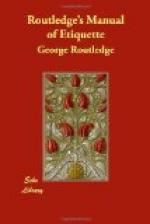We have already remarked that this Valse is incorrect in time. Two steps can never properly be made to occupy the space of three beats in the music. The ear requires that each beat shall have its step; unless, as in the Cellarius, an express pause be made on one beat. This inaccuracy in the measure has exposed the Valse a Deux Temps to the just censure of musicians, but has never interfered with its success among dancers. We must caution our readers, however, against one mistake often made by the inexperienced. They imagine that it is unnecessary to observe any rule of time in this dance, and are perfectly careless whether they begin the step at the beginning, end, or middle of the bar. This is quite inadmissible. Every bar must contain within its three beats two steps. These steps must begin and end strictly with the beginning and end of each bar; otherwise a hopeless confusion of the measure will ensue. Precision in this matter is the more requisite, because of the peculiarity in the measure. If the first step in each bar be not strongly marked, the valse measure has no chance of making itself apparent; and the dance becomes a meaningless galop.
The step contains two movements, a glissade and a chassez, following each other quickly in the same direction. Gentleman begins as usual with his left foot; lady with her right.
1st beat.—Glissade to the left with left foot.
2nd and 3rd beats.—Chassez in the same direction with right foot; do not turn in this first bar.
2nd bar, 1st beat.—Slide right foot backwards, turning half round.
2nd and 3rd beat.—Pass left foot behind right, and chassez forward with it, turning half round to complete the figure en tournant. Finish with right foot in front, and begin over again with left foot.
There is no variation in this step; but you can vary the movement by going backwards or forwards at pleasure, instead of continuing the rotatory motion. The Valse a Deux Temps, like the Polka, admits of a reverse step; but it is difficult, and looks awkward unless executed to perfection. The first requisite in this Valse is to avoid all jumping movements. The feet must glide smoothly and swiftly over the floor, and be raised from it as little as possible. Being so very quick a dance, it must be performed quietly, otherwise it is liable to become ungraceful and vulgar. The steps should be short, and the knees slightly bent.
As the movement is necessarily very rapid, the danger of collisions is proportionately increased; and gentlemen will do well to remember and act upon the cautions contained in the previous pages of this book, under the head of “The Polka”.
They should also be scrupulous not to attempt to conduct a lady through this Valse until they have thoroughly mastered the step and well practised the figure en tournant. Awkwardness or inexperience doubles the risks of a collision; which, in this extremely rapid dance, might be attended with serious consequences.




